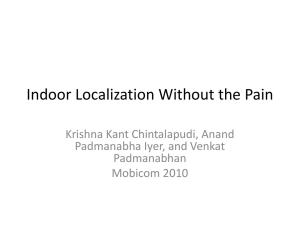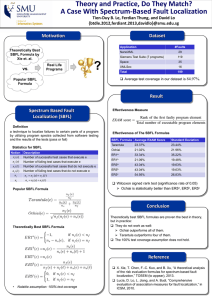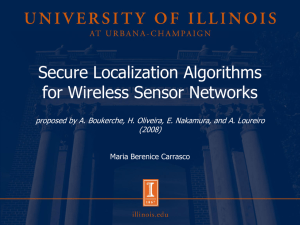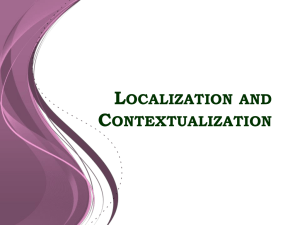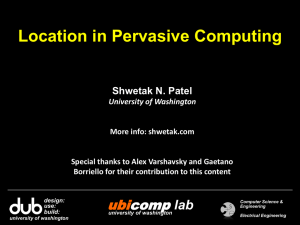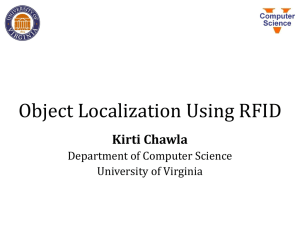RFID Object Localization
advertisement
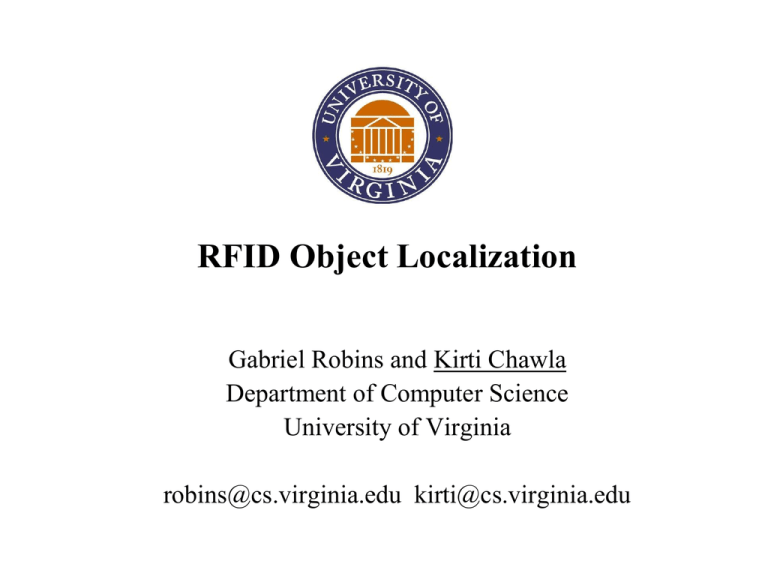
RFID Object Localization Gabriel Robins and Kirti Chawla Department of Computer Science University of Virginia robins@cs.virginia.edu kirti@cs.virginia.edu 02/33 Outline • • • • • • What is Object Localization ? Background Motivation Localizing Objects using RFID Experimental Evaluation Conclusion 03/33 What is Object Localization ? Objects Environments Goal: Find positions of objects in the environment Problem: Devise an object localization approach with good performance and wide applicability 04/33 Current Situation Lots of approaches and applications lead to vast disorganized research space Satellites Signal strength Lasers Signal arrival time Ultrasound sensors Signal arrival angle Cameras Signal phase Technologies Techniques Stationary object localization • Inapplicable • Not general • Mismatched Mobile object localization Indoor localization Outdoor localization Applications • Identify limitations • Determine suitability 05/33 Localization Type Self • Self-aware of position • Processing capability Environmental • Not aware of position • Optional processing capability 06/33 Localization Technique • • • • • • • Signal arrival time Signal arrival difference time Signal strength Signal arrival phase Signal arrival angle Landmarks Analytics (combines above techniques with analytical methods) 07/33 RFID Technology Primer RFID tag RFID reader Inductive Coupling Backscatter Coupling • Interact at various RF frequencies • Passive • Semi-passive • Active 08/33 Motivating RFID-based Localization • • • • • • Low-visibility environments Not direct line of sight Beyond solid obstacles Cost-effective Adaptive to flexible application requirements Good localization performance 09/33 State-of-the-art in RFID Localization RFID –based localization approaches Pure Hybrid 10/33 Contributions • Pure RFID-based environmental localization framework with good performance and wide applicability • Key localization challenges that impact performance and applicability 11/33 Power-Distance Relationship • Empirical powerdistance relationship • Cannot determine tag position Reader power R eader P ow er T ag P ow er Distance Tag power 4 × π × D ista n c e R e a d e r G a in × T a g G a in × W a ve le n g th N 12/33 Empirical Power-Distance Relationship Insight: Tags with very similar behaviors are very close to each other Key Challenges 13/33 Results Tag Sensitivity 13 % • Variable sensitivities • Bin tags on sensitivity Pile of tags 25 % 54 % High sensitive Average sensitive 8% Low sensitive Results 14/33 Reliability through Multi-tags Platform design Insight: Multi-tags have better detectabilities (Bolotnyy and Robins, 2007) due to orientation and redundancy 15/33 Tag Localization Approach Setup phase Localization phase 16/33 Algorithm: Linear Search • Linearly increments the reader power from lowest to highest (LH) or highest to lowest (HL) • Reports the first power level at which a tag is detected as the minimum tag detection power level • Localizes the tags in a serial manner • Time-complexity is: O(# tags power levels) 17/33 Algorithm: Binary Search • Exponentially converges to the minimum tag detection power level • Localizes the tags in a serial manner • Time-complexity is: O(# tags log(power levels)) 18/33 Algorithm: Parallel Search • Linearly decrements the reader power from highest to lowest power level • Reports the first power level at which a tag is detected as the minimum tag detection power level • Localizes the tags in a parallel manner • Time-complexity is: O(power levels) 19/33 Reader Localization Approach Setup phase Localization phase 20/33 Algorithm: Measure and Report • Reports a 2-tuple TagID, Timestamp after reading a neighborhood tag • Sorted timestamps identify object’s motion path • Time-complexity is: O(1) 21/33 Error-reducing Heuristics Localization Error • Reference tag’s location as object’s location leads to error • Number selection criteria of 22/33 Experimental Setup Track design Mobile robot design 4 X-axis 1 3 2 Y-axis 23/33 Experimental Evaluation • Empirical power-distance relationship • Localization performance • Impact of number of tags on localization performance 24/33 Empirical Power-Distance Relationship 25/33 Localization Accuracy 26/33 Algorithmic Variability 27/33 Localization Time 28/33 Performance Vs Number of Tags Diminishing returns 29/33 Comparison with Existing Approaches Hybrid Hybrid 30/33 Visualization Heuristics Work area Accuracy Antenna control 31/33 Deliverables Patent(s): 1. Kirti Chawla, and Gabriel Robins, Method, System and Computer Program Product for LowCost Power-Provident Object Localization using Ubiquitous RFID Infrastructure, UVA Patent Foundation, University of Virginia, 2010, US Patent Application Number: 61/386,646. Journal Publication(s): 2. Kirti Chawla, and Gabriel Robins, An RFID-Based Object Localization Framework, International Journal of Radio Frequency Identification Technology and Applications, Inderscience Publishers, 2011, Vol. 3, Nos. 1/2, pp. 2-30. Conference Publication(s): 3. Kirti Chawla, Gabriel Robins, and Liuyi Zhang, Efficient RFID-Based Mobile Object Localization, Proceedings of IEEE International Conference on Wireless and Mobile Computing, Networking and Communications, 2010, Canada, pp. 683-690. 4. Kirti Chawla, Gabriel Robins, and Liuyi Zhang, Object Localization using RFID, Proceedings of IEEE International Symposium on Wireless Pervasive Computing, 2010, Italy, pp. 301306. Grant(s): 5. Gabriel Robins (PI), NSF Grant on RFID Pending 32/33 Conclusion • • • • Pure RFID-based object localization framework Key localization challenges Power-distance relationship is a reliable indicator Extendible to other scenarios 33/33 Thank You 34 Backup Slides 35 Back Key Localization Challenges RF interference Occlusions Tag sensitivity Tag spatiality Tag orientation Reader locality Back Single Tag Calibration Constant distance/Variable power Variable distance/Constant power 36 Back Multi-Tag Calibration: Proximity Constant distance/Variable power Variable distance/Constant power 37 Back Multi-Tag Calibration: Rotation 1 Constant distance/Variable power 38 Back Multi-Tag Calibration: Rotation 2 Variable distance/Constant power 39 40 Back Error-Reducing Heuristics Heuristics: Absolute difference M H 1 : M in ( Δ I (R J )) J I =1 M H 2 : M in ( Δ I (R J ) + J,K JK Δ I =1 I =1 M M H 3 : M in ( Δ I (R J ) + J,K JK M I =1 Δ I (R K )) I (R K )) I =1 J, K are n eig h b o rs M H 4 : M in ( Δ I (R J ) + J,K JK I =1 M Δ M I (R K )) su ch th at I =1 Δ I =1 J, K are n eig h b o rs M I (R J ) < Δ I =1 I (R K ) Back Error-Reducing Heuristics Heuristics: Minimum power reader selection H 5 : M in (Δ J (T ) + Δ K (T )) J,K ,S ,Q JK S Q J, K are planar orthogonally oriented H 6 : M in (Δ J (T ) + Δ K (T )) J,K ,S ,Q JK S Q S , Q are neighbors 41 42 Back Error-Reducing Heuristics Heuristics: Root sum square absolute difference M Δ H 7 : M in ( J 2 I (R J ) ) I=1 M H 8 : M in ( J,K JK Δ M 2 I (R J ) + I=1 J,K JK Δ 2 I (R K ) ) I (R K ) ) I=1 M H 9 : M in ( Δ M 2 I (R J ) + Δ I=1 2 I=1 J, K are neighbors M H 10 : M in ( J,K JK Δ I=1 M 2 I (R J ) + Δ M 2 I (R K ) ) such that I=1 Δ I=1 J, K are neighbors M 2 I (R J ) < Δ I=1 I (R K ) 2 43 Back Error-Reducing Heuristics Absolute difference Minimum power reader selection Localization error Meta-Heuristic Root sum square absolute difference Other heuristics
